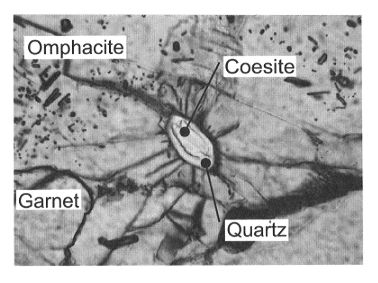

A new project started this summer concerns the metamorphic evolution
of high pressure rocks, dominantly eclogites, from the High Himalayan Crystalline,
Pakistan. The first definite eclogites in the Himalaya were reported only
in the early 1990's and there are still only two areas where eclogites
have been identified - both in the northwestern part of the mountain belt.
In comparison to European continental collision belts such as the Alps,
Variscides, or Caledonides, eclogites are extraordinarily scarce in the
Himalayas and other characteristic high pressure rocks, such as garnet
peridotite, are completely unknown. It was a major surprise, therefore,
when coesite was discovered during initial petrographic investigation of
the newly collected material - the first ever finding of coesite from Himalayan
rocks. The coesite, enclosed in clinopyroxene (omphacite), shows the characteristic
breakdown to radiating (palisade-texture) quartz as well as the typical
radiating network of fractures in the host pyroxene (Fig. 3.4-5).
 |
|
|
The coesite was confirmed by Raman spectroscopy (with the help of N. Zotov) and could easily be distinguished from the surrounding quartz. The minimum formation conditions for coesite, at the temperatures deduced from garnet-clinopyroxene geothermometry (around 650°C), are around 2.6 GPa. This finding has major implications for the interpretation of the geological evolution of the Himalaya. First, as mafic lenses in the Higher Himalayan Crystalline have been interpreted as Permian extrusive and intrusive rocks, their host of granitic basement and its sedimentary cover must also have been subducted to depths of over 90 km. Second, exhumation rates and exhumation models for the various metamorphic rocks in the area have been estimated based on conservative pressure estimates for the previously studied eclogites and must now be significantly modified (pressure, i.e. depth estimate, must be almost doubled). The solution to the exhumation of rocks from coesite-forming depths, and more importantly the metastable preservation of coesite, may well be due to the buoyancy of the relatively low density (compared to the mantle) subducted continental crust slice hosting the eclogites.

Tel: +49-(0) 921 55 3700 / 3766, Fax: +49-(0) 921 55 3769, E-mail: bayerisches.geoinstitut(at)uni-bayreuth.de
 Previous page
Previous page